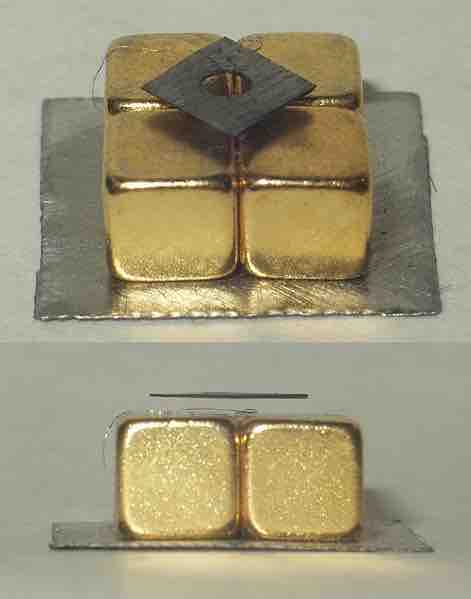Paramagnetism
Paramagnetism is a form of magnetism whereby the paramagnetic material is only attracted when in the presence of an externally applied magnetic field. Paramagnetic materials have a relative magnetic permeability greater or equal to unity (i.e., a positive magnetic susceptibility) and hence are attracted to magnetic fields. The magnetic moment induced by the applied field is linear in the field strength; it is also rather weak.
Constituent atoms or molecules of paramagnetic materials have permanent magnetic moments (dipoles), even in the absence of an applied field. Generally, the permanent moment is caused by the spin of unpaired electrons in atomic or molecular electron orbitals. In pure paramagnetism, the dipoles do not interact with each other and are randomly oriented in the absence of an external field due to thermal agitation; this results in a zero net magnetic moment. When a magnetic field is applied, the dipoles will tend to align with the applied field, resulting in a net magnetic moment in the direction of the applied field.
Paramagnetic materials have a small, positive susceptibility to magnetic fields. These materials are slightly attracted by a magnetic field and the material does not retain the magnetic properties when the external field is removed, as illustrated in . Paramagnetic properties are due to the presence of some unpaired electrons, and from the realignment of the electron paths caused by the external magnetic field.

Paramagnetic Materials and Electric Fields
Orientation in paramagnetic material when electric field is applied (right image) and removed (left image).
Paramagnetic materials include magnesium, molybdenum, lithium and tantalum. Unlike ferromagnets, paramagnets do not retain any magnetization in the absence of an externally applied magnetic field, because thermal motion randomizes the spin orientations responsible for magnetism. Some paramagnetic materials retain spin disorder at absolute zero (meaning they are paramagnetic in the ground state). Thus the total magnetization drops to zero when the applied field is removed. Even in the presence of the field there is only a small induced magnetization because only a small fraction of the spins will be oriented by the field.
Diamagnetism
Diamagnetism is the property of an object or material that causes it to create a magnetic field in opposition to an externally applied magnetic field. Thus, unlike paramagnets, diamagnets are repelled by magnetic fields, which can lead to its unusual effects, such as levitation of diamagnetic material when located above powerful magnet (as shown in ).

Levitating Carbon
Pyrolytic carbon levitating over permanent magnets
Diamagnetism, to a greater or lesser degree, is a property of all materials and it always makes a weak contribution to the material's response to a magnetic field. However, for materials that display some other form of magnetism (such as ferromagnetism or paramagnetism), the diamagnetic contribution becomes negligible. In addition, all conductors exhibit an effective diamagnetism when they experience a changing magnetic field. For example, the Lorentz force on electrons causes them to circulate around forming eddy currents. The eddy currents then produce an induced magnetic field opposite the applied field, resisting the conductor's motion.